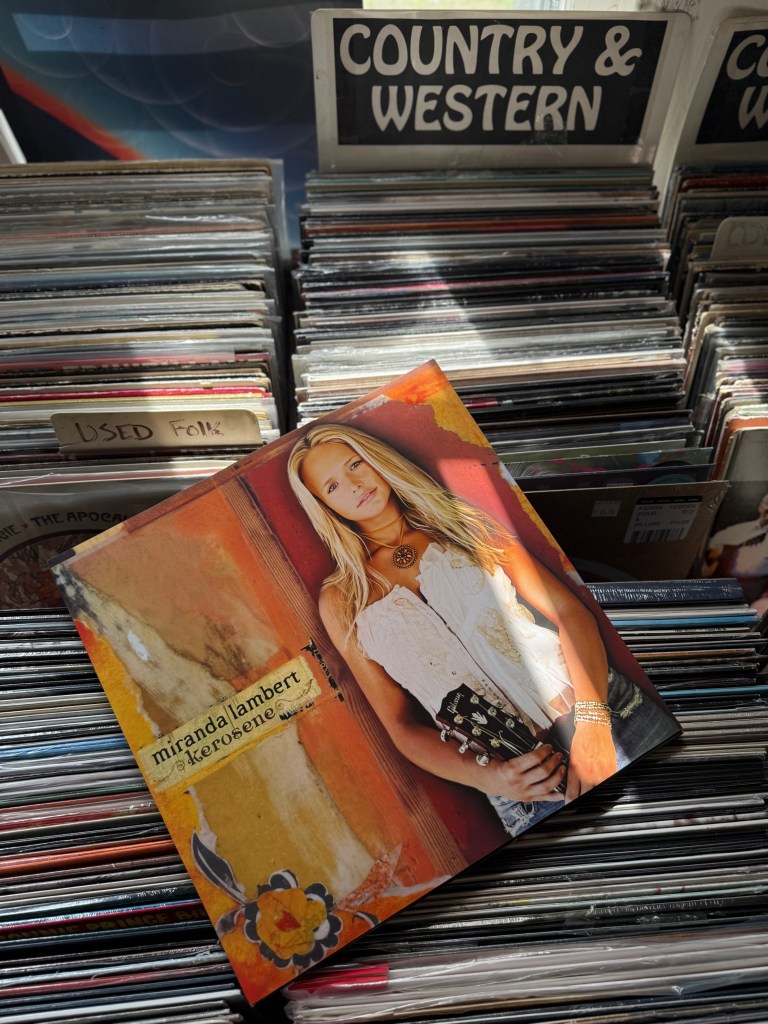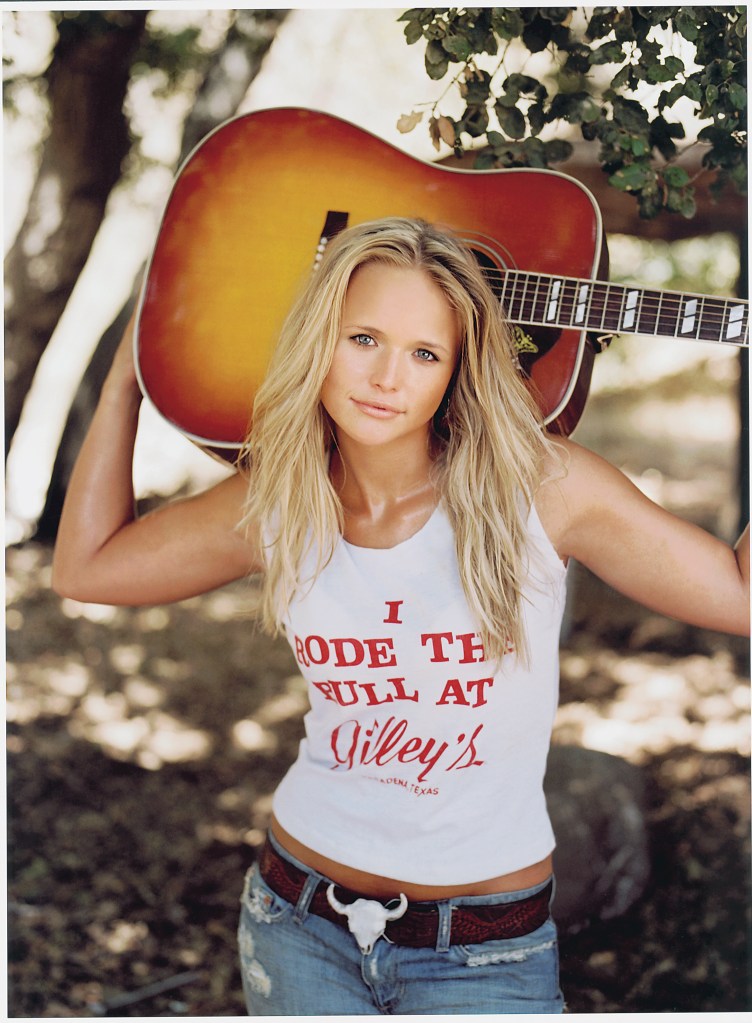Miranda Lambert often refers to the younger self showcased on her 2005 debut album, “Kerosene,” as “baby me.” At that time, she was like an artistic toddler with a penchant for fire. This spark ignited by her thoroughly formed first record under Sony Nashville transformed Lambert from merely being a symbol for women in country music during a pivotal period following the Dixie Chicks’ controversy, into one of the most influential musicians within the genre’s legacy. All these elements were evident right from her initial significant label release, particularly highlighted in the breakout title track, alongside softer, more introspective tracks surrounding it.
The “Kerosene” album, which was previously shelved (pardon the pun), is now getting a new release from Sony in two different versions. Surprisingly, it has never been released on vinyl until now, so this gap will finally be filled.
The LP version will be released on April 25.
Digitally, the album is now available and supported by additional elements.
previously unheard outtake titled “I Don’t Love Here Anymore.”
(Check out the newly released bonus track, below.)
Lambert has been quite busy in her career recently beyond just reminiscing. Last year, she signed with the Republic label and released her inaugural album under this banner, titled “Postcards From Texas.” However, she was pleased to discuss these developments.
Big News Hub
regarding her joy in commemorating the 20th anniversary of the album that first got her onto the dance floor.
Many artists look back on their first album with a sense of embarrassment over certain aspects. They might want to alter parts of it or felt pressured by their record label in various ways. Discovering your identity as an artist during that period can be challenging for anyone.
Sure thing! When I found out we’d be revisiting “Kerosene,” I gave it another spin, and thought to myself, yeah, I’m really pleased with how far I’ve come. It makes me proud, and I believe in sharing that journey because I hope to inspire upcoming musicians to create something they’d proudly present to their idols. For me, that’s always been an important benchmark. Even now, I think handing this album directly to someone like George Strait wouldn’t leave me feeling embarrassed—it would actually fill me with pride.
The digital edition of the reissue includes this additional never-before-released track titled “I Don’t Love Here Anymore.” Was it originally recorded during those same sessions?
This is a fresh recording from those sessions, which honestly I had completely forgotten existed. Marion (Kraft, her longtime collaborator), however, was contemplating ideas for celebrating the 20th anniversary when she stumbled upon this piece and retrieved it from storage. This discovery makes me genuinely happy; hearing it again brings back memories as it feels like listening to my younger self. The song has a touch of vulnerability due to its age but being its creator fills me with pride and excitement at sharing it now.
Is owning a vinyl version important to you? Different folks feel differently about this.
I’m genuinely thrilled about this. It’s great to see people are enthusiastic about vinyl at present, and I find it wonderful that young folks are embracing it once more since collecting records is truly an awesome hobby. Having grown up before this resurgence, I feel incredibly grateful for being able to experience it nowadays.
It’s amusing how you refer to the period in the ’90s and 2000s as “old-school,” particularly since during that time, vinyl was thought to be obsolete and few new albums came out on LP records. It seems like vinyl missed several generations before making a comeback, which means people from your age group likely didn’t encounter it growing up unless they had access through their parents’ collections.
Sure, I didn’t. My collection was limited to CDs. Before that, though, I started with cassettes and then moved on to CDs. However, my father has gradually passed down his vinyl records to me, which has been quite an interesting journey going right back to where things began.

Is the 20
th
Was the anniversary of your major-label debut something you gave considerable thought to as it neared?
Sort of. As I’ve mentioned multiple times, certain days make me feel like I’ve been doing this for 200 days, while other days feel more like 200 years; it varies. Despite these feelings, I’m still passionate about it, and “Kerosene” fills me with immense pride—it’s set me up for success over the coming twenty years in music.
It’s amusing because I don’t sense much change within myself. Going through old archival material—interviews and performances—from earlier periods has made me laugh. These clips show young me, yet they capture the same spirited essence I possess today. In terms of personal growth, not too many changes have occurred—I remain true to who I fundamentally am both personally and creatively. However, my songwriting skills, artistic expression, and perspective as a woman have certainly developed. Yet, that fiery spirit remains intact—the one that defined me right from the start.
I believe those initial experiences playing honky-tonks down in Texas were crucial in shaping my identity as an artist. Reflecting on those formative moments allows me to appreciate learning about myself before venturing into something entirely different like Nashville. Those foundational lessons gave me clarity regarding self-expression and resilience even amidst unfamiliar challenges.
Throughout my whole career, I’ve maintained that approach. Looking back now, maybe I started off a bit aggressively. At the time, though, being young and unyielding, I thought, “If things don’t pan out here, going back to Texas would be fine.” My mindset then was not wanting to alter myself for anybody; I simply presented who I truly was. In retrospect, perhaps it demonstrated some courage – although I realize today that adding a touch more gentleness might have helped. Still, I held firm convictions regarding both my aspirations and how I wished to present myself to the public. It’s heartening knowing that many loyal followers from those early days still support me and even bring along their children to concerts, ensuring these younger generations get exposed to two-decade-old tracks. Truly grateful that such timeless appeal has endured all these years.
Is there a particular sleeper hit from the “Kerosene” album that you enjoy?
I believe ‘Love Is Looking for You’ is likely one of my top favorites.
The album failed to generate any major hit singles initially. “Me and CharlieTalking” served as the lead single but did not perform particularly well; however, it helped establish you as a reputable artist. The titular song eventually became one of your most enduring tracks, reaching number 15—a solid achievement for you at that point.
It wasn’t until “Revolution,” my third album, that I made it into the top five. It definitely took some time.
When you began at Sony, you collaborated with Tracy Gershon as your A&R, which meant you had robust supporters.
Tracy and John Grady, who was then the head of Sony Nashville, would say, “Make the album you’re passionate about; that’s why we signed you.” I’m incredibly grateful for their support since things often turn out differently, unfortunately. They expressed confidence in me with an attitude of, “We believe in your vision,” which made all the difference. When I proposed having Frank Liddell produce the record, feeling very confident about my decision, they backed me up completely without hesitation. This level of backing from the label truly stood out as something genuinely remarkable.
When people used to inquire about me, they often asked, “Will you become the next Dixie Chicks? Or perhaps the following LeAnn Rimes?” My standard response was typically, “I’m going to be the first Miranda Lambert,” as I aimed at being genuinely myself. This approach helped guide me successfully throughout these past two decades. Now, embarking upon an entirely fresh chapter with a brand-new recording contract seems exhilarating. Despite all changes, staying true within this industry remains vital for me, largely due to maintaining authenticity—a trait I hold dear in every artist.
Certainly, you switched over to Republic Records last year. Are you at ease collaborating with your former label for this special release?
I agree. My entire musical career has unfolded within Sony, where I spent two decades. Over those years, they’ve built strong ties with me and accomplished significant milestones together. It feels good to collaborate again as their involvement remains crucial; I deeply appreciate their support. This partnership holds considerable significance as it forms an essential thread in the tapestry of my journey.

This summer, you’re performing at stadiums alongside Morgan Wallen. In the realm of country music, it seems that big-name artists usually prefer joining someone else’s stadium tour as supporting acts rather than headlining their own events whenever possible. Brooks and Dunn will be opening for you during these shows too. Does this arrangement hold particular allure for you?
Sure thing! What’s really exciting is that we’re stepping onto an enormous platform here. Particularly when dealing with artists from different generations such as Morgan, everything feels fresh and vibrant; it opens up opportunities to connect with audiences who might not have encountered our work yet, which thrills me. “Let’s dive right into it,” I say enthusiastically. “This will demonstrate exactly where our generation stands.” Another perk I’m looking forward to is wrapping up around 8:30 PM so I’ll still have plenty of time to kick back and enjoy watching the performance unfold. Having played countless gigs over the years, occasionally feeling drained after late slots has become somewhat routine for me. This setup promises to be fantastic though. Plus, I genuinely believe Morgan puts on an incredible show, one filled with top-notch tunes. Our collaborations have always gone smoothly, leading seamlessly into songwriting sessions too. There’s simply a natural synergy between us both. Moreover, he hasn’t shied away from expressing admiration towards my professional journey publicly. Now seems absolutely ideal to introduce him to my fanbase and allow them insight into his artistry, fostering mutual discovery among attendees.
On an entirely different subject: We just got wind of a major Miranda-inspired drag event scheduled in Austin.
I’m really enthusiastic about this event. It’s going to be a grand showcase of our entire collection, featuring all the bold tunes performed by every fabulous drag queen. What excites me the most is that I can simply attend and enjoy myself thoroughly. Over the years, I’ve contributed many spirited tracks to the drag scene, and I find this incredibly gratifying. Being able to witness it firsthand makes it even more thrilling for me. My sibling along with their spouse and all our mutual pals from Austin will also be present, making it an extra-special occasion.
Being recognized as a drag icon might not be common knowledge for everyone, yet with such an abundance of Dolly Parton-inspired looks and occasionally some inspired by Shania Twain, it naturally follows that there would also be a style influenced by Miranda Lambert.
Sure, when you consider the names you just brought up, entering that realm means you’ve really arrived—you become a single-namer celebrity then. Think about it: we have Dolly and Shania, Reba, Cher, and Mariah. It’s tempting; I’m thinking “Count me in.”
.
More from The Big News Center
- Morgan Wallen Announces ‘I’m the Problem’ Summer Stadium Tour, Titled After His Upcoming Fourth Album
- Miranda Lambert Discusses Marking Twenty Years in the Industry, Switching Record Labels, Reaching 40, and Sharing ‘Postcards From Texas’: ‘The Flame Burns Brighter Than Ever’